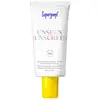What's inside
What's inside
 Key Ingredients
Key Ingredients

 Benefits
Benefits

 Concerns
Concerns

 Ingredients Side-by-side
Ingredients Side-by-side

Butyl Methoxydibenzoylmethane 3%
UV AbsorberHomosalate 8%
Skin ConditioningEthylhexyl Salicylate 5%
UV AbsorberOctocrylene 4%
UV AbsorberIsododecane
EmollientDimethicone Crosspolymer
Emulsion StabilisingDimethicone/Bis-Isobutyl PPG-20 Crosspolymer
EmollientPolymethylsilsesquioxane
Isohexadecane
EmollientDicaprylyl Carbonate
EmollientMeadowfoam Estolide
Skin ConditioningCaprylic/Capric Triglyceride
MaskingPolyester-7
Skin ConditioningNeopentyl Glycol Diheptanoate
EmollientLithothamnion Calcareum Extract
Skin ConditioningCaprylyl Glycol
EmollientButyrospermum Parkii Butter
Skin ConditioningJojoba Esters
EmollientMannitol
HumectantBoswellia Serrata Resin Extract
SmoothingLecithin
EmollientMicrocrystalline Cellulose
AbsorbentDiatomaceous Earth
AbrasiveZinc Sulfate
AntimicrobialSilica
AbrasiveTocopherol
AntioxidantButyl Methoxydibenzoylmethane 3%, Homosalate 8%, Ethylhexyl Salicylate 5%, Octocrylene 4%, Isododecane, Dimethicone Crosspolymer, Dimethicone/Bis-Isobutyl PPG-20 Crosspolymer, Polymethylsilsesquioxane, Isohexadecane, Dicaprylyl Carbonate, Meadowfoam Estolide, Caprylic/Capric Triglyceride, Polyester-7, Neopentyl Glycol Diheptanoate, Lithothamnion Calcareum Extract, Caprylyl Glycol, Butyrospermum Parkii Butter, Jojoba Esters, Mannitol, Boswellia Serrata Resin Extract, Lecithin, Microcrystalline Cellulose, Diatomaceous Earth, Zinc Sulfate, Silica, Tocopherol
Zinc Oxide 13%
Cosmetic ColorantWater
Skin ConditioningTetradecane
PerfumingCetearyl Nonanoate
EmollientEthylhexyl Palmitate
EmollientCaprylic/Capric Triglyceride
MaskingIsopropyl Palmitate
EmollientIsopropyl Myristate
EmollientGlycerin
HumectantPolyglyceryl-3 Diisostearate
EmulsifyingMica
Cosmetic ColorantPropanediol
SolventDisteardimonium Hectorite
StabilisingGluconolactone
Skin ConditioningPolyglyceryl-6 Polyricinoleate
EmulsifyingBrassica Campestris/Aleurites Fordi Oil Copolymer
Skin ConditioningPolyhydroxystearic Acid
EmulsifyingSodium Chloride
MaskingMagnesium Sulfate
Fructose
HumectantOctyldodecyl Oleate
EmollientTocopherol
AntioxidantCocos Nucifera Fruit Extract
EmollientSodium Benzoate
MaskingCI 77492
Cosmetic ColorantDodecane
PerfumingHexadecane
PerfumingCI 77891
Cosmetic ColorantWithania Somnifera Flower Extract
Skin ConditioningCI 77491
Cosmetic ColorantVaccinium Angustifolium Fruit Extract
Skin ProtectingSilica
AbrasiveCalcium Gluconate
HumectantZinc Oxide 13%, Water, Tetradecane, Cetearyl Nonanoate, Ethylhexyl Palmitate, Caprylic/Capric Triglyceride, Isopropyl Palmitate, Isopropyl Myristate, Glycerin, Polyglyceryl-3 Diisostearate, Mica, Propanediol, Disteardimonium Hectorite, Gluconolactone, Polyglyceryl-6 Polyricinoleate, Brassica Campestris/Aleurites Fordi Oil Copolymer, Polyhydroxystearic Acid, Sodium Chloride, Magnesium Sulfate, Fructose, Octyldodecyl Oleate, Tocopherol, Cocos Nucifera Fruit Extract, Sodium Benzoate, CI 77492, Dodecane, Hexadecane, CI 77891, Withania Somnifera Flower Extract, CI 77491, Vaccinium Angustifolium Fruit Extract, Silica, Calcium Gluconate
 Reviews
Reviews

Ingredients Explained
These ingredients are found in both products.
Ingredients higher up in an ingredient list are typically present in a larger amount.
This ingredient is an emollient, solvent, and texture enhancer. It is considered a skin-softener by helping the skin prevent moisture loss.
It helps thicken a product's formula and makes it easier to spread by dissolving clumping compounds.
Caprylic Triglyceride is made by combining glycerin with coconut oil, forming a clear liquid.
While there is an assumption Caprylic Triglyceride can clog pores due to it being derived from coconut oil, there is no research supporting this.
Learn more about Caprylic/Capric TriglycerideSilica, also known as silicon dioxide, is a naturally occurring mineral. It is used as a fine, spherical, and porous powder in cosmetics.
Though it has exfoliant properties, the function of silica varies depending on the product.
The unique structure of silica enhances the spreadability and adds smoothness, making it a great texture enhancer.
It is also used as an active carrier, emulsifier, and mattifier due to its ability to absorb excess oil.
In some products, tiny microneedles called spicules are made from silica or hydrolyzed sponge. When you rub them in, they lightly polish away dead skin layers and enhance the penetration of active ingredients.
Learn more about SilicaTocopherol (also known as Vitamin E) is a common antioxidant used to help protect the skin from free-radicals and strengthen the skin barrier. It's also fat soluble - this means our skin is great at absorbing it.
Vitamin E also helps keep your natural skin lipids healthy. Your lipid skin barrier naturally consists of lipids, ceramides, and fatty acids. Vitamin E offers extra protection for your skin’s lipid barrier, keeping your skin healthy and nourished.
Another benefit is a bit of UV protection. Vitamin E helps reduce the damage caused by UVB rays. (It should not replace your sunscreen). Combining it with Vitamin C can decrease sunburned cells and hyperpigmentation after UV exposure.
You might have noticed Vitamin E + C often paired together. This is because it is great at stabilizing Vitamin C. Using the two together helps increase the effectiveness of both ingredients.
There are often claims that Vitamin E can reduce/prevent scarring, but these claims haven't been confirmed by scientific research.
Learn more about Tocopherol